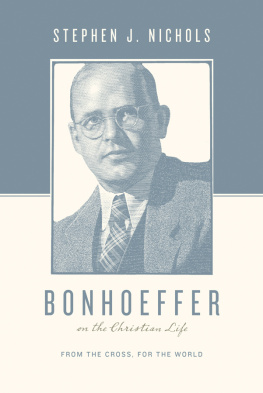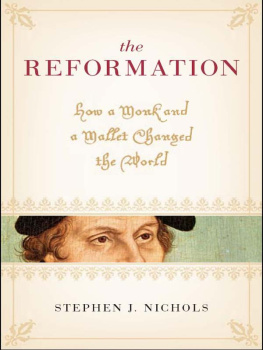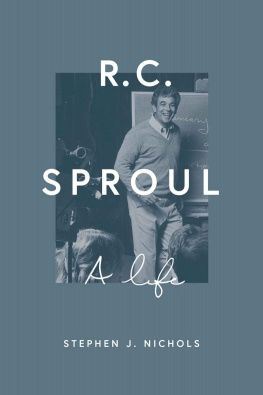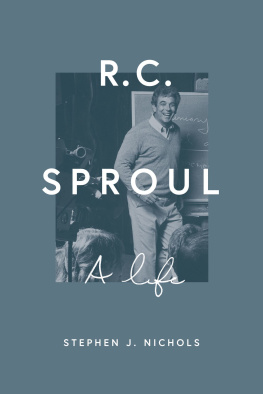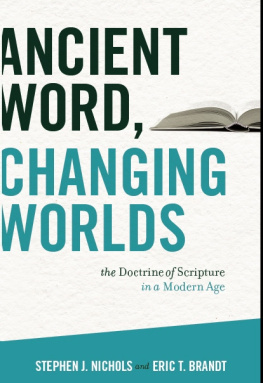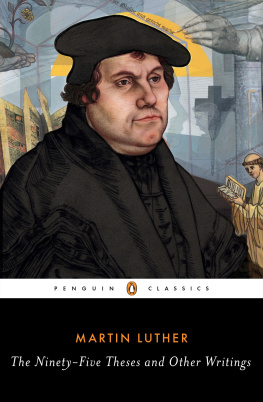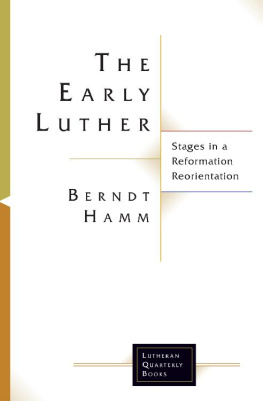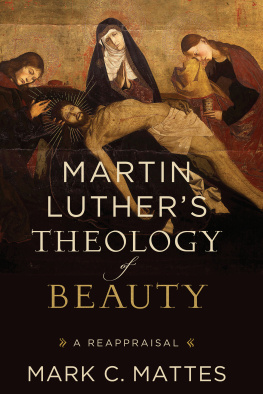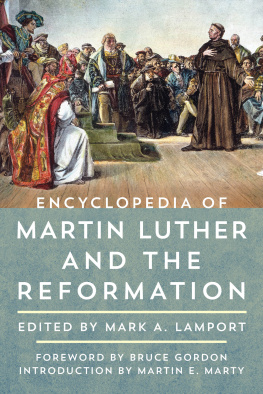How do you do a book on everything from training children to sing hymns to preaching to political conflictand have it running over with the glorious gospel? Nichols has done it. Be alert: people forget how life-changing the gospel really isand then are astonished to remember it again as they read Luther.
D. Clair Davis , Emeritus Professor of Church History, Westminster Theological Seminary, Philadelphia
A marvelous mixture of biography, history, theology, and anecdote. If you dont feel the heartbeat of the Reformation in these pages, check your pulse!
Sinclair Ferguson , Coauthor, Church History 101
Stephen Nicholss engaging volume deserves to be widely read, and as an unashamed Luther-lover I hope it will be.
J. I. Packer , Professor of Theology, Regent College
Nichols has a gift for making a complex subject simple without being simplistic.
Michael A. Rogers , Senior Pastor, Westminster Presbyterian Church, Lancaster, Pennsylvania
As we celebrate the 500th anniversary of the Reformation, may we not only appreciate the profound ways God used Martin Luther, but may we learn from him. Dr. Nichols gives us a front-row seat on Luthers life. As we watch, may we have the same boldness and the same lifelong commitment to the gospel.
R.C. Sproul , Founder, Ligonier Ministries
Rarely do we find the rich combination of theological precision and historical passion so accessibly written as we do here in Dr. Nichols entertaining treatment of Martin Luther. A marvelous introduction.
Derek W. H. Thomas , Professor of Systematic and Pastoral Theology, Reformed Theological Seminary, Atlanta
Those who know nothing of Luther will benefit greatly from such a readable introduction, while those more familiar with him will find Nichols enthusiasm infectious.
Carl B. Trueman , Professor of Church History, Westminster Theological Seminary, Philadelphia
BEYOND
THE 95 THESES
Martin Luthers Life, Thought, and Lasting Legacy
Stephen J. Nichols
2016 by Stephen J. Nichols
Originally published in 2002 as two separate volumes
Martin Luther: A Guided Tour of His Life and Thought copyright 2002 by Stephen J. Nichols
Martin Luthers Ninety-Five Theses copyright 2002 by Stephen J. Nichols
All rights reserved. No part of this book may be reproduced, stored in a retrieval system, or transmitted in any form or by any meanselectronic, mechanical, photocopy, recording, or otherwiseexcept for brief quotations for the purpose of review or comment, without the prior permission of the publisher, P&R Publishing Company, P.O. Box 817, Phillipsburg, New Jersey 08865-0817.
Unless otherwise indicated, Scripture quotations are from the HOLY BIBLE, NEW INTERNATIONAL VERSION. NIV. Copyright 1973, 1978, 1984 by International Bible Society. Used by permission of Zondervan Publishing House. All rights reserved.
Scripture quotations marked ASV are taken from the American Standard Version (1901).
Permission to use figures 1.2, 1.3, 2.2, 2.3, 3.2, 4.2, 5.1, 6.2, 7.2, 11.2, and 12.1 has been granted by the Richard C. Kessler Reformation Collections of the Pitts Theology Library, Candler School of Theology, Emory University.
Figure 8.1 from Martin Luther, Lutherifches ABC und Ramen-Buchlein fr Kinder (Philadelphia: Schfer und Koradi, N.D.); Figure 8.2 from Martin Luther, Dr. Martin Luther Der kleine Katechismus (Munich: Mller, 1933); Figure 9.1originally appeared in Sartains Union Magazine of Literature and Art, vol. 5, 1849; Figure 10.2 from Moritz Meurer, The Life of Martin Luther (New York: H. Ludwig & Co., 1848); Figure 13.1 is from Julius Theodor Kostlin, Life of Luther (New York: Scribners, 1923), 537.
Italics within Scripture quotations indicate emphasis added.
ISBN: 978-1-62995-331-1 (pbk)
ISBN: 978-1-62995-332-8 (ePub)
ISBN: 978-1-62995-333-5 (Mobi)
Printed in the United States of America
Library of Congress Control Number: 2016958703
For Benjamin Hunt Nichols
May you grow to appreciate and embrace
the rich heritage of Christ's church.
CONTENTS
ILLUSTRATIONS
1.1 Timeline: Early Years
1.2 The Seven-Headed Luther (1529)
1.3 Title page of Johann von Staupitzs Examination of Eternal Predestination (1517)
2.1 Timeline: Later Years
2.2 Samson Slays a Lion, title page of Luthers pamphlet in response to the Catholic theologians of Louvain
2.3 Martin Luther (1546)
3.1 The Reformation Solas
3.2 Title page of Luthers Commentary on Galatians
4.1 Luthers Decisive Year (1520)
4.2 Title page of the Papal Bull issued by Leo X (1520)
5.1 Desiderius Erasmus (14661536)
6.1 Major Writings on the Lords Supper and Related Events
6.2 Ulrich Zwingli (14841531)
7.1 Major Ethical Writings
7.2 Title page of Whether One May Flee from a Deadly Plague (1527)
8.1 Title page of Luthers ABC Book for Children
8.2 Title page from a German edition of Luthers Small Catechism
9.1 Evenings at the Luther Home
10.1 A Mighty Fortress Is Our God
10.2 The Castle at Wartburg
11.1 Marks of the True Church
11.2 Lutheran Worship Service (ca. 1550)
12.1 Lucas Cranachs illustration of Genesis 22 from Luthers German translation of the Bible (1523)
13.1 Wittenberg (1546)
PREFACE
M ARTIN LUTHER stepped out of the Black Cloister in Wittenberg. In this building he and his fellow Augustinian monks, university scholars, and students taught and learned, ate and drank, prayed and slept. Here Martin Luther lived. Here, too, he wrote. He passed through the gate and headed west, guided by the bell tower and steeple of the Schlosskirche, or Castle Church, that rose over the town of Wittenberg. Luther likely could make the trip in his sleep. One kilometer later he arrived at his destination.
Martin Luther had been troubled in the months of 1517. In fact, Martin Luther had been troubled for the past dozen years and, sadly, more years still. In 1505 he had found himself caught in a violent thunderstorm, which he had taken to be nothing less than Gods judgment over his soul and Gods way of snuffing out his life. Having no alternative, Luther had cut a deal. He would enter the monastery, devoting his life to the quest for piety and peace with Godif only God spared his life from the crashing thunder and streaking lightning.
In the years leading up to 1517, Luthers troubles increased. Peace seemed ever more to elude him. He had high hopes for the churchand at the time there was only one, the Roman Catholic Churchyet he experienced wave upon wave of disillusionment. His trip to Rome, the Holy See, left him utterly deflated.
Then Luther started to hear stories that made his skin crawl and his stomach churn. In the neighboring regions, an indulgence sale was occurring. The Peter Indulgence, as it was called, resulted from a deal struck by Albert, Archbishop of Mainz, and Pope Leo X. Unprecedented, the indulgence offered purchasers a free pass to paradise, no need to stop in purgatory. It also offered release from purgatory for ones relatives, ones suffering relatives. All one had to do was throw a coin into the coffer.




